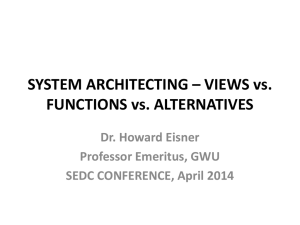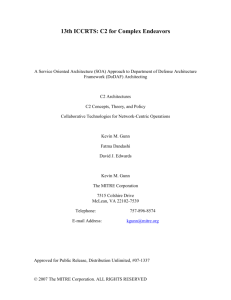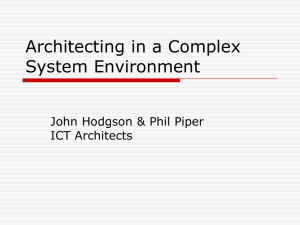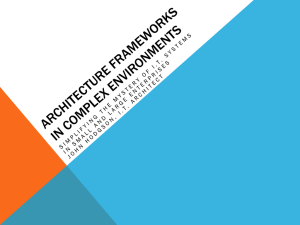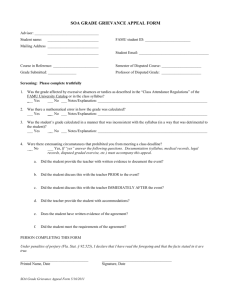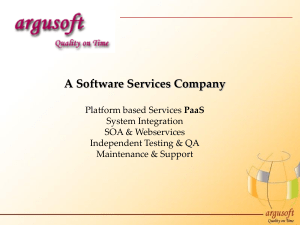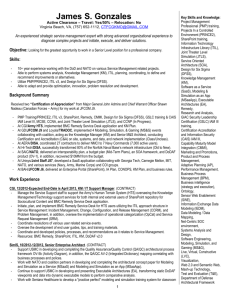SOA Extensions to DODAF - Object Management Group
advertisement
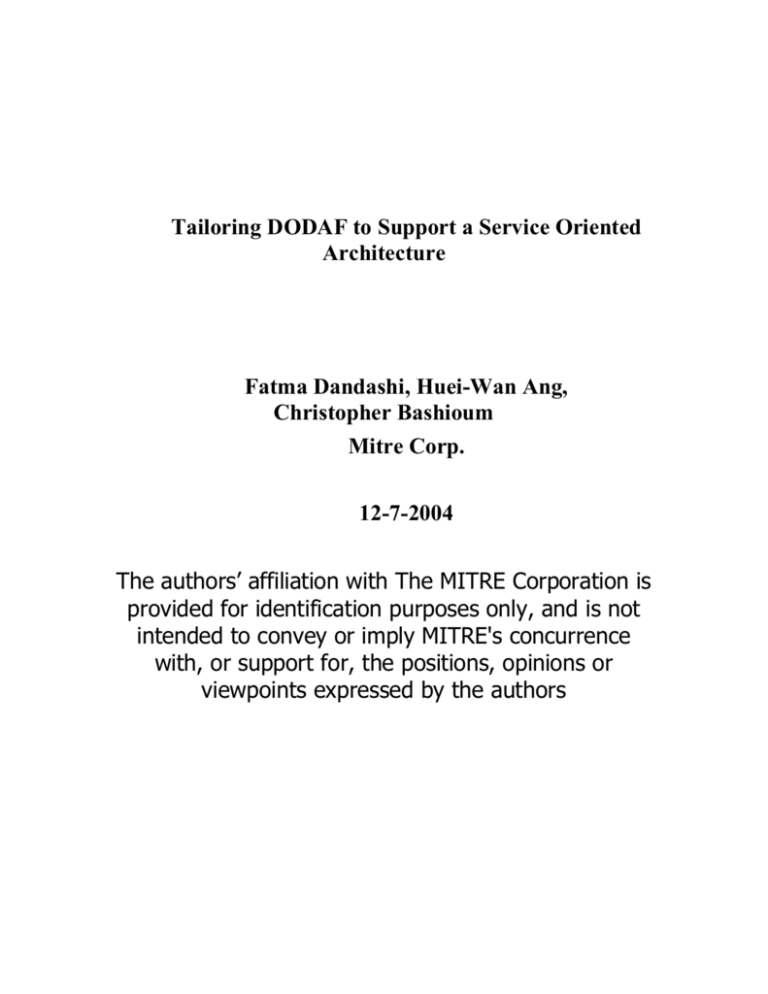
Tailoring DODAF to Support a Service Oriented Architecture Fatma Dandashi, Huei-Wan Ang, Christopher Bashioum Mitre Corp. 12-7-2004 The authors’ affiliation with The MITRE Corporation is provided for identification purposes only, and is not intended to convey or imply MITRE's concurrence with, or support for, the positions, opinions or viewpoints expressed by the authors DRAFT Table of Contents TABLE OF CONTENTS .............................................................................................................. II 1 INTRODUCTION ................................................................................................................ 1 2 SERVICE ORIENTED ARCHITECTURE ....................................................................... 1 3 4 2.1 SOA GENERIC CHARACTERISTICS ................................................................................. 1 2.2 INTERFACE-BASED DESIGN ........................................................................................... 2 2.3 SOA LAYERS ................................................................................................................. 3 2.3.1 SOA Infrastructure Layer ......................................................................................... 3 2.3.2 SOA Application Layer ............................................................................................. 3 THE ARGUMENT FOR SHOWING SOA WITHIN DODAF ........................................ 4 3.1 ASSERTION: ONE CAN DESCRIBE SOA WITH DODAF .................................................... 4 3.2 BENEFITS OF USING SOA APPROACH WITHIN DODAF ................................................. 4 3.3 ADDRESSING ARGUMENTS AGAINST USING DODAF WITH SOA ................................. 5 TAILORING DODAF TO SUPPORT A SERVICE ORIENTED APPROACH ........... 6 4.1 4.1.1 5 The Use of A Metamodel .......................................................................................... 9 4.2 TAILORING THE DODAF PRODUCTS ............................................................................12 4.3 SOA PERSPECTIVES ......................................................................................................13 4.3.1 Enterprise ................................................................................................................13 4.3.2 Service Provider ......................................................................................................13 4.3.3 Infrastructure Service Provider ...............................................................................14 4.3.4 Organizing Architecture Artifacts by SOA Perspectives .........................................14 AN EXAMPLE SERVICE ORIENTED ARCHIECTURE USING DODAF ................14 5.1 NODE TRANSPARENT VERSION OF SV-1 .......................................................................14 5.1.1 Example Node Transparent Version of SV-1 from Enterprise Perspective .............14 5.1.2 Example Node Transparent Version of SV-1 from Service Provider Perspective ...15 5.1.3 Example Node Transparent Version of SV-1 from Infrastructure Service Provider Perspective 6 TAILORING THE DODAF ELEMENTS AND RELATIONSHIPS............................................. 7 16 5.2 EXAMPLE INTER-NODAL VERSION OF SV-1 .................................................................17 5.3 EXAMPLE SV-10C .........................................................................................................18 SUMMARY ..........................................................................................................................19 WHITE PAPER PAGE II OF 24 II DRAFT REFERENCES ..............................................................................................................................20 WHITE PAPER PAGE III OF 24 III DRAFT 1 INTRODUCTION Using models to architect, design, and drive complex system development is not new. Over 4000 years ago, ancient Egyptians developed scale and mathematical models to architect their pyramids. Through the use of these models Egyptians were able to build pyramids that have withstood the test of time. This chapter explores a framework for modeling enterprise and system of systems architecture –DODAF, and how DODAF can be tailored to describe a Service Oriented Architecture. The Department of Defense (DoD) Architecture Framework (DoDAF) “defines a common approach for … architecture description development, presentation, and integration … The framework is intended to ensure that architecture descriptions can be compared and related across boundaries …” As such, DoDAF identifies a set of architecture elements and their relationships to be used for developing and presenting architecture models. DODAF does not prescribe any particular methodology or process for creating the actual architecture model, but only the elements and relationships that any given methodology would use. However, DoDAF allows tailoring of the elements and relationships. A Service Oriented Architecture (SOA) “is an approach to defining integration architectures based on the concept of a service. It applies successful concepts proved by Object Oriented development, Component Based Design, and Enterprise Application Integration technology. The goal of SOA can be described as bringing the benefits of loose coupling and encapsulation to integration at an enterprise level.” [IBM, 2004] SOA defines an approach for defining an architecture vs. any particular set of architectural elements that might be used for describing (or presenting) that architecture. .This difference allows DoDAF to be able to effectively describe an SOA. However, because DoDAF terminology and descriptions have not been tailored for SOA, some tailoring is required to better support SOA design patterns within the DoDAF. This paper discusses tailoring DoDAF to show SOA. It starts with a background on SOA, presents argument for representing SOA in DoDAF, goes on to discuss how DoDAF can be tailored to support SOA more effectively, discusses specific SOA characteristics that can be represented in DoDAF, and provides some examples of SOA using DoDAF. 2 SERVICE ORIENTED ARCHITECTURE A basic background in SOAs is presented here in order to give some context for the rest of the paper. Much of the text in the below subsections borrows heavily from “Patterns: Service Oriented Architecture and Web Services” [IBM, 2004]. 2.1 SOA GENERIC CHARACTERISTICS A service is generally implemented as a coarse-grained, discoverable software entity that exists as a single instance and interacts with applications and other services through a loosely coupled, message-based communication model. WHITE PAPER PAGE 1 OF 24 1 DRAFT The goal of SOA is to alleviate the problems of heterogeneity, interoperability and ever changing requirements. A SOA architecture should provide a platform for building application services with the following characteristics: Loosely coupled Location transparent Protocol independent Based on such a service-oriented architecture, a service consumer does not need to know about the physical characteristics of a particular service provider it is communicating with because the underlying infrastructure, or service “bus”, will locate the appropriate service provider on behalf of the consumer. In addition, the infrastructure hides as many technicalities as possible from a service consumer. Particularly technical specificities from different implementation technologies such as J2EE or .NET for the service providers should not affect the implementation of the service consumers. Reconsideration and substitution of a “better” service implementation with better quality of service characteristics should not have any impact on the service consumers, except for potential interface changes. Key service-oriented terminology: Services: Logical entities, the contracts defined by one or more published interfaces. Service provider: The software entity that implements a service specification. Service consumer (or requestor): The software entity that calls a service provider. Traditionally, this is termed a “client”. A service consumer can be an end-user application or another service. Service locator: A specific kind of service provider that acts as a registry and allows for the lookup of service provider interfaces and service locations. Service broker: A specific kind of service provider that can pass on service requests to one or more additional service providers. 2.2 INTERFACE-BASED DESIGN In service development, the design of the interfaces is done such that a software entity implements and exposes a key part of its definition. Therefore, the notion and concept of “interface” is key to successful design in service-oriented systems. The following are some key interface-related definitions: Interface: Defines a set of public method signatures, logically grouped but providing no implementation. An interface defines a contract between the consumer and provider of a service. Any implementation of an interface must provide all methods. Published interface: An interface that is uniquely identifiable and made available through a registry for service consumers to dynamically discover. WHITE PAPER PAGE 2 OF 24 2 DRAFT Public interface: An interface that is available for service consumers to use but is not published, thus requiring static knowledge on the part of the service consumer. Dual interface: Frequently, interfaces are developed as pairs such that one interface depends on another; for example, a service requester must implement an interface because the service provider interface provides some callback mechanism. 2.3 SOA LAYERS An effective enterprise-wide SOA will involve 3 layers. The first and obvious layer is the network. While it is vital to the implementation of services, in this paper, we will assume adequate network support is present. The second and third layers are an SOA infrastructure layer and an SOA “application” layer. 2.3.1 SOA Infrastructure Layer The SOA infrastructure is generally a static structure consisting of those services that support the dynamic binding between service consumers and service providers. These infrastructure (or backplane) services include service mediators, and security, logging and storage services. Service mediators are a specific kind of service providers that enable discovery of application layer services and facilitate their invocation by allowing service registration and lookup, routing of service requests, transformation of message formats, and conversion of transport protocols. Example service mediators include service registry, service broker, service locator, and messaging middleware. Without service mediators, service consumers and service providers can only communicate via pre-defined point-to-point connections and no dynamic service binding is possible. The SOA infrastructure determines the extent of allowable interactions between service consumers and service providers (with or without service mediators) and the extent of allowable paths of services. Any expected or desired service provider invocation from a service consumer not supported by the SOA infrastructure indicates a new requirement for the SOA infrastructure or a requirement for a point to point connection between the service consumer and provider. Any path of services containing service invocations not supported by the SOA infrastructure is not a valid path of services. 2.3.2 SOA Application Layer The SOA “application” layer is where providers and consumers of the business logic or transactional services are located. The connections between application layer service providers and their prospective service consumers are generally more dynamic in nature, and there may be many instantiations of the service provider for any given service. Some examples of services in the application layer would be language translation services or data fusion services. With the support from the infrastructure layer, ad hoc data flows and service paths due to mission changes, fail-over, or load balancing can occur at this layer. All the benefits and characteristics of SOA such as loosely coupled and location transparent are manifested at this layer. WHITE PAPER PAGE 3 OF 24 3 DRAFT 3 THE ARGUMENT FOR SHOWING SOA WITHIN DODAF 3.1 ASSERTION: ONE CAN DESCRIBE SOA WITH DODAF Within the federal government, software services are an integral part of the business process. Specifically within DoD, software services are imbedded on hardware platforms that provide needed functionality to the warfighter. These services cannot be developed or used without considering the context in which they will fit, the systems with which they need to interoperate, and the environment in which they will be deployed (people, processes, business functions they support, etc.). As a framework for system of systems architecture modeling, DoDAF (with minor tailoring described in section 4 of this document) can fulfill the need to describe enterprise-wide services in the context of the operational constructs in which they will fit, the systems (hardware and software) within which the services are implemented and with which the services need to interoperate, and the operational environment (people, processes, functions) where the services are provided and used. 3.2 BENEFITS OF USING SOA APPROACH WITHIN DODAF The main value in tailoring DoDAF to more effectively show SOA is to avoid the potential consequences of using specialized frameworks outside of DoDAF to describe SOAs (leading to multiple incompatible frameworks and incomparable architectures). DoDAF and its C4ISR Architecture Framework predecessor have been in use across the DoD to describe architectures since 1996. Several federal agencies [DHS, 2004, Treasury, 2000] have adopted the vocabulary (operational activities, information exchange, etc.) as well as the visualization products (e.g. OV-5 activity hierarchy) from DoDAF to describe their architectures. As DoD subcontractors, a large section of the systems engineering and manufacturing industry has adopted DoDAF as part of their Systems Engineering process (e.g., Northrop Grumman, Lockheed Martin, Boeing), and industry consortia are currently working on adopting the DoDAF vocabulary and products to complement their standardized approaches to systems and software development [Bailey, 2003a, Bailey, 2004, OpenGroup, 2004]. As a result, there exists a large embedded base of architectural artifacts that were created using the DoDAF, and a large body of people in the government and industry that have developed a understanding of DoDAF (see list of references addressing the use of C4ISR AF and DODAF). The following is a short list of existing programs that make use of the DODAF: Net-Centric Enterprise Services (NCES) Architecture DoD’s Business Modernization Program (BMMP) Architecture US Coast Guard Enterprise Architecture US Army Architecture US Navy, and US Marine Corps Enterprise Architectures FORCENet Enterprise Architectures Other DOD EA (Army Future Combat Systems, AF C2 Constellation Architecture, etc.) Other Non-DOD EA WHITE PAPER PAGE 4 OF 24 4 DRAFT GIG Architecture, GIG Information Assurance Architecture, and NetCentric Reference Model (NCOW) Using DoDAF to show SOA would leverage this existing base of knowledge and extant architectural artifacts as government and industry move towards designing and implementing SOAs. This would help ensure that architecture descriptions can be compared and related across organizational boundaries, including Joint and multinational boundaries, and it would be consistent with the purpose of creating the DODAF – which is to define a common approach for describing, presenting, and comparing DoD architectures and facilitating the use of common principles, assumptions and terminology. SOA is an orientation or methodology applied when defining systems architecture primitives or elements, specifically, services, client system functions of services, and other system elements that enable the provision and consumption of services. Another advantage to using DODAF to describe service oriented architectures is the ability to describe a business need (covered in DODAF by a description of a capability, its operational activities, and their associated information flows), and its justification for the elements defined in the Systems View. With the application of a SOA methodology to the Systems View, one can tie the business needs to the services, service providers, and service consumers that support the business needs. 3.3 ADDRESSING ARGUMENTS AGAINST USING DODAF WITH SOA The following three common arguments against using DODAF to show a Services Oriented Architecture have been made at various times: DODAF and SOA are competing architectures DODAF can only show ‘point to point’ connections whereas SOA is “everything to everything” connections DODAF can only show a static architecture vs. the dynamic architecture of an SOA It is our assertion that these arguments are based on a misunderstanding of SOA and/or a narrow view of DODAF. We will answer each argument in turn. The first argument is really based on a fundamental misunderstanding of both SOA and DODAF. DODAF is a framework that organizes architecture products according to the “view” or “perspective” of the architecture that the specific products expose. This is similar to having different perspectives or views of a building architecture (plan view, front view, side view, etc.). SOA, on the other hand, is an orientation or methodology applied when defining the primitives used within the DODAF (or any other framework). This is similar in concept to an architect applying an object oriented methodology to create an architecture model using DODAF elements and relationships. DoDAF does not prescribe OO methodology, but it is a framework that supports it. In the same way, the service orientation (or SOA methodology) can be used within DoDAF. (Note – a corollary of this is that SOAs can be described with other frameworks). Concerning the second argument, the assertion that DoDAF is point-to-point and SOA is everything-to-everything does not accurately identify the real issue. When people say that DoDAF is “point-to-point”, they generally mean that DoDAF shows an WHITE PAPER PAGE 5 OF 24 5 DRAFT exhaustive list of connections among systems or services and the two sides of a connection have knowledge about how to interface with each other. In other words, the only information flows (shown in the operational views) and data flows (shown in the system views) that can exist in the enterprise are those that are defined in the architectural artifacts and there must be tight coupling between each pair of systems or services on the two sides of each connection. No other information/data flows exist or can exist. When people say that SOA means “everything-to-everything” they imply that there is no value is highlighting specific information/data flows and service providers and their prospective service consumers don’t have to know about each other a-priori. Both of these statements are false. DoDAF is not constrained to show all of the possible information flows in the enterprise being architected – the artifacts only have to show those flows that are of interest at a given point in time. The implication is that other flows of information/data are still possible, and may show up in later revisions to the architectural products. It is better in this sense to consider the DoDAF artifacts as a snapshot in time of “key” information/data flows. In addition, DoDAF is not constrained to only show information/data flows between two tightly coupled parties that know about how to connect to each other. Pre-defined flows of information and of data between known endpoints are important in SOAs as they give justification for the creation of a service in the first place, and they are helpful in identifying sizing requirements for the service. In DoDAF or SOA, there is nothing precluding the service from being re-used in another ad-hoc information or data flow. Additionally, this a-priori knowledge captured in the DODAF can be used to validate the usefulness of existing services or to identify where services may be missing. The SOA infrastructure, and use of Web Services standards in implementing the SOA allow for much lower overhead in creating new (ad-hoc, or temporary) information and data flows, but these flows have to be constructed from and are completely dependent on the pre-defined flows and the SOA infrastructure and can’t be created arbitrarily. Concerning the third argument, the dynamic nature of a service-oriented architecture has to do with the fact that service endpoints may appear on or disappear from the enterprise network at will, and that DoDAF cannot capture this ad-hoc nature of the enterprise SOA. In answer to this, consider that in order for the ad-hoc nature of the enterprise SOA to “work”, there must be a relatively static SOA infrastructure (registries, discovery tools) to support this capability. Otherwise, nobody on the network would ever know that a service became available. In this paper, the authors provide a metamodel and examples of how DoDAF can be used to show the infrastructure as well as ad-hoc data flows that are supported by the described SOA infrastructure. 4 TAILORING DODAF TO SUPPORT A SERVICE ORIENTED APPROACH The DoDAF is intended to provide a common approach for creating architecture models that can be used to describe, present, and compare architectures with the prescription of 26 architecture products grouped into three views. Each of the 26 DoDAF product sections in DoDAF includes narratives, templates or examples, and a table of WHITE PAPER PAGE 6 OF 24 6 DRAFT architecture data elements (with attributes) and relationships. The narratives provide product definitions, purposes, and general descriptions. The templates or examples in each DoDAF product section demonstrate how an architecture description can be visually presented from the aspect of that DoDAF product. The data elements and relationships table in each DoDAF product section lists and defines the classes of architecture data and relationships that are needed to describe an architecture from the aspect of that DoDAF product. Three basic steps are required to tailor DODAF to effectively support describing service oriented architectures. The first step is to modify existing DoDAF-defined architecture data elements, element relationships, and element attributes, and add new ones where needed, to more effectively describe SOA approach and concepts. The second step is to modify existing DoDAF product narratives, templates, and examples to allow visual representation of the modified or new SOA data elements and relationships in particular; and to support better visual representation of service oriented architectures in general. The third step is to provide guidance on how to organize DoDAF product artifacts or federate architectures according to SOA perspectives. The next subsections present the specific tailoring of the DoDAF elements and relationships, explain how the tailored elements and relationships support SOA approach and concepts, illustrates the tailored DoDAF elements and relationships with sub-views of a metamodel, and then discuss the tailoring of the DoDAF product definitions, templates, and examples and how service oriented architectures can be effectively represented visually with the tailored DoDAF products. 4.1 TAILORING THE DODAF ELEMENTS AND RELATIONSHIPS Current DODAF elements and their relationships are not sufficient to model service oriented architectures as these require more descriptive detail in terms of their loose coupling and interface-based design characteristics. Specifically, DODAF elements and relationships must be tailored to capture the concepts of service, service providers, service consumers, and service mediators. DoDAF must be tailored to accommodate a detailed service definition including information about interface, performance, service level, security, and implementation constraints. In addition, DODAF must also be tailored to allow for conveying multiple instantiations of service providers and consumers in order to better capture the dynamic nature of the SOA application layer. The new and tailored DoDAF elements and relationships are listed and explained below. Service is added as a specialization of System Function since Service is a special kind of System Function with well defined interface. Service is defined with the following attributes: o interface description o security description o transaction description o management description WHITE PAPER PAGE 7 OF 24 7 DRAFT System Role is added to capture the concept of roles played by systems, which allows for the separation of requirements or responsibilities of systems (logical) from the actual systems (physical). ‘System fulfills Systems Role’ relationship is added to allow an actual system to be related to zero, one, or more system roles that it fulfills. Service Provider is added as specialization of System Role since it is a special kind of System Role; specifically, service providers play the role of providing services. Service Mediator is added as a specialization of Service Provider since it is a special kind of Service Provider; specifically, service mediators play the role of providing infrastructure types of services. Service Registry, Service Locator, Service Broker are added as specializations of Service Mediator since they are special kinds of Service Mediator and instances of each provide a special kind of infrastructure services. Quality Requirement and Constraint and their relationships to System Function are added to allow performance, service level requirements, and implementation constraints to be specified on services since Service is a specialization of System Function. Systems At Node is added to resolve the many to many relationship, ‘Systems Node groups System’ Systems At Node Interface is added to represent the inter-nodal version of system-system interface described in current DoDAF SV-1 section. System Role Interface is added to represent the concept of a logical interface between system roles (as opposed to DODAF’s Systems Interface which is ambiguous and is thought to represent the concept of physical connections between systems). System Role Service Dependency is added as a specialization of System Role Interface to represent the service dependency of a system role on a service provider, indicating that the system role consumes the service provided by the service provider. Performer is added to capture the concept of actual human resources, which allows for the separation of responsibilities of human resources represented by Performer Role from the actual human resources represented by Performer. The ‘Performer fulfills Performer Role’ relationship is added to allow Performer to be related to the Performer Role that it fulfills. Product is added to represent things produced and consumed by System Function and is specialized by Material (also a new element) and Data. The introduction of Product and Material allows for exchanges of physical substances (in addition to data and information) that were not directly supported by DoDAF. System Product Flow expands System Data Flow to allow flow of either Material or Data between system functions. COI is added to represent the concept of Community of Interest, which is a group of performers that have common interests such as shared missions. WHITE PAPER PAGE 8 OF 24 8 DRAFT Vocabulary is added to represent the concept of reference models or taxonomies of data. Data Reference is added to represent the concept of common terms of references. ‘COI comprises Performer’, ‘COI defines Vocabulary’, ‘Vocabulary comprises Data Reference’, and ‘Data defined by Data Reference’ relationships are added (together with other existing relationships) to represent the concept that a COI is a collection of performers who exchange data using a common vocabulary in support of shared missions, business processes, and objectives. 4.1.1 The Use of A Metamodel A metamodel is defined in dictionary.com as ‘a model that defines the components of a conceptual model, process, or system.’ Underlying the 26 DoDAF products, there is an implicit metamodel that ensures that the DoDAF elements and relationships are defined consistently within and across the 26 DoDAF products as parts of a coherent structure. There are many benefits to creating and maintaining an explicit DoDAF metamodel following any standard conceptual modeling methodology. As the explicit DoDAF metamodel is created, ambiguities and inconsistencies among current DoDAF elements and relationships will be revealed and will have to be resolved since a metamodel is rigorous and doesn’t allow for ambiguities or inconsistencies. In addition, this explicit DoDAF metamodel can be used as a means to evolve and improve DoDAF consistently to support new architecture uses such as SOA since it prevents duplicated or inconsistent data elements and relationships from being introduced. Another benefit of an explicit DoDAF metamodel is that it provides an overall picture of the common approach intended by DoDAF and enables the visualization of this overall picture and any portions of it (sub-views) as necessary. Sub-views are usually intended to show portions of the overall picture with only the elements and relationships that are relevant to an aspect, usually corresponding to a DoDAF product. With the visualization of an explicit DoDAF metamodel and its sub-views enabled, conceptual understanding of the common approach intended by DoDAF can be enhanced. Several initiatives have been undertaken to create such an explicit DoDAF metamodel. The tailoring of DoDAF elements and relationships presented in this paper builds on the work from one of these initiatives to rigorously define a DODAF metamodel in UML. Specifically, an explicit metamodel has been used as a means to ensure that inconsistencies and duplications are not introduced by the tailored data elements and relationships. Presenting the complete DoDAF metamodel is outside the scope of this paper. The following diagrams are sub-views of this DoDAF metamodel, which include and illustrate only the elements and relationships that are relevant to various aspects of SOA. WHITE PAPER PAGE 9 OF 24 9 DRAFT System decomposes originates from fulfills decomposes SystemRoleInterface terminates at SystemRole service consumer performs SystemFunction decomposes originates from ServiceDependency terminates at ServiceProvider Service ServiceMediator ServiceBroker ServiceLocator ServiceRegistry Figure 1. DODAF Metamodel Sub-View for Node Transparent Version of SV-1 Figure 1 is a metamodel sub-view that shows elements and relationships that support the location transparent and dynamic characteristics of SOA through the use of System Role (including service providers and service mediators) and System Role Interface (including Service Dependency). System Role Interface denotes a logical system interface that can be realized by more than one actual System Interfaces. A System Role Interface is realized by a System Interface if the Systems on the two sides of the realizing System Interface fulfill the System Roles on the two sides of the realized System Role Interface respectively. Service Dependency is a special kind of System Role Interface and its terminating side has to be a Service Provider. Since System Role and System Role Interface denote requirements and functionality independent of the actual Systems, they are node and location transparent. WHITE PAPER PAGE 10 OF 24 10 DRAFT SystemsNode originates from SystemAtNodeInterface terminates at groups SystemAtNode references System decomposes /performs decomposes SystemFunction Service Figure 2. DODAF Metamodel Subview for Internodal Version of SV-1 Figure 2 is a metamodel sub-view that shows elements and relationships that capture the loose coupling characteristics of SOA. Specifically, a Service is a kind of System Function that a certain System performs. Various Systems (not necessary the same kind) can fulfill the same System Role and can be deployed at one or more Systems Nodes. Loose coupling among Systems can be captured via the use of System, Service, and System At Node Interface. In particular, all Systems that interface directly or indirectly with a certain System providing a certain Service via one or more System At Node Interface are portrayed as having the potential of consuming the provided Service. In addition, this portrayal indicates that all potential service consumers are to conform to the service interface as defined (i.e., they abide by the published interface for the System providing the Service). Figure 2 also shows that the deployments of physical Systems (instances) on Systems Nodes are captured via System At Node. WHITE PAPER PAGE 11 OF 24 11 DRAFT COI Performer comprises decomposes fulfills SystemProductFlow OperationalRole terminates at originates from decomposes transports SystemFunction decomposes accomplishes OperationalActivity supports consumes decomposes produces measured by Service Constraint Product defines measured by QualityRequirement Material Data defined by Vocabulary comprises DataReference Figure 3. DODAF Metamodel Sub-View for SV-4 Figure 3 is a metamodel sub-view that shows elements and relationships that support the interface-based characteristic of SOA. In particular, all interface related information of a service can be captured with attributes of and relationships to Service and is applicable to all potential consumers of the service. The same interface related information doesn’t have to be duplicated for each additional consumer of the service. This metamodel sub-view also shows DoDAF’s current support for the capturing of apriori data flows and added support for a-priori product flows. In particular, system product flows can be used to indicate pre-existing knowledge about flows of data or products between system functions. 4.2 TAILORING THE DODAF PRODUCTS All architecture products may be generated or created by an architect from the composition of elements and relationships that are described in the DODAF metamodel. That is, DODAF products are simply projections of the architecture model into specific diagrams or matrixes for easy viewing. There exists a large number of products one can create by showing selected elements and their relationships, in diagram and/or matrix format. For example, a single enterprise architecture for the Army may contain one set of DoDAF products focusing on the architecture from a business perspective and a different WHITE PAPER PAGE 12 OF 24 12 DRAFT set of DoDAF products focusing on the same architecture from a Command and Control perspective. DODAF V 1.0 defines some key products in the OV, SV and TV views so architects can have a common language. The architect remains free to tailor or add more products. However, there are some products that are particularly applicable to describing a services-oriented architecture. These will be described in a follow-on paper that builds on work from another Mitre initiative [MITRE, 2004]. We provide some tailored products by way of example in section 5. In developing these examples, we considered the perspectives discussed in section 4.3 below. 4.3 SOA PERSPECTIVES 4.3.1 Enterprise From the enterprise perspective, the focus is on what business services (as opposed to infrastructure services) are needed, and the providers that provide and the consumers that consume the business services. The view is from “outside” the service interface, and the emphasis is on the behavior of the service from an external perspective (i.e., it describes the black box perspective). Characteristics of the enterprise perspective include the following: The service is described by its interface The service looks like a black box. Any infrastructure services that are used, such as security and user authentication, are also considered as black boxes on the network. Standards applicable to the “backplane” are identified, e.g., XACML, UDDI, WSDL, SOAP, DIME, etc. 4.3.2 Service Provider From the service provider perspective, the view is from behind the interface, and its focus is to describe the “innards” of the service (i.e., it describes the white box perspective). This perspective, or view, shows how infrastructure services are implemented and/or executed. Characteristics of the service provider perspective include the following: Security attributes have to be fully specified since the service has to validate credentials. The registry (or registries) used to enable discovery of this service by others needs to be identified (i.e., where the service of concern will be registered). The standards applicable to the service (or services) of concern must be identified, e.g., FIPS Pub 151-1 (POSIX.1), etc. WHITE PAPER PAGE 13 OF 24 13 DRAFT 4.3.3 Infrastructure Service Provider From the infrastructure service provider perspective, the focus is on what infrastructure services are needed to facilitate or enable the interactions between business service providers and consumers. 4.3.4 Organizing Architecture Artifacts by SOA Perspectives Any given architecture is comprised of underlying architecture data and these architecture data and DoDAF views and products can be used to organize or present the architecture data according to the perspectives intended by the views (Operational, Systems, Technical) and the aspects intended by the products. The architects are also free to organize the underlying architecture data and DoDAF product artifacts according to the stakeholders’ perspectives or other kinds of perspectives depending on the purpose of the architecture. Guidance on organizing DoDAF product artifacts based on the three SOA perspectives described earlier in this paper will be developed as follow-on work. 5 AN EXAMPLE SERVICE ORIENTED ARCHIECTURE USING DODAF 5.1 NODE TRANSPARENT VERSION OF SV-1 The node transparent version of SV-1 is a new diagram that shows system roles (representation of a system’s responsibility, not any specific instance of a system), system role interfaces, service dependencies, services provided by those systems, as well as systems functions not classified as services. This SV-1 artifact allows depiction of service dependencies between system instances at the level of system roles. The intent is to allow multiple potential system service dependencies of the same kind to only have to be shown once. Notice that system nodes are not shown in this SV-1 version since the focus is the service dependencies between system roles, which are intended to represent system responsibilities (as opposed to physical system instances) and do not make sense to be deployed on system nodes. 5.1.1 Example Node Transparent Version of SV-1 from Enterprise Perspective Figure 4 is an example node transparent version of SV-1 that shows service dependency from the enterprise perspective, which focuses on what business services (as opposed to infrastructure services) are available and who provides and consumes them. Payment Processor is a service provider, providing a Process Payment service. Systems Tax Collector and Parking Ticket Payment Collector are system roles that consume the Process Payment service. WHITE PAPER PAGE 14 OF 24 14 DRAFT Physical system instances, and systems nodes are not shown Tax Collector Collect Tax Service consumer Payment Processor : Service Provider Legend Systems Node Process Payment Service Parking Ticket Payment Collector Collect Payment name: specialization Service consumer System Role Physical System Instance Service/System Function Port/Published Interface System Role Interface Figure 4. SV-1 Node Transparent Version Showing Service Dependency from Enterprise Perspective 5.1.2 Example Node Transparent Version of SV-1 from Service Provider Perspective Figure 5 is an example node transparent version of SV-1 that shows service dependency from the service provider perspective, which focuses on the implementation of the service provider and what services it depends to in order to provide its own service to its consumers. System Payment Processor provides a Process Payment service (to other consumers not shown in this diagram). Payment Processor system in turn utilizes other services provided by other provider systems, namely Credit Card Payment Processor, E-Check Processor, and Logger systems providing the Process Credit Card Payment, Process E-Check, and Logging services, respectively WHITE PAPER PAGE 15 OF 24 15 DRAFT Credit Card Payment Processor :Service Provider Process Credit Card Payment Service Payment Processor Service consumer Logger:Service Provider Service consumer Process Payment Service Logging Service Service consumer Legend Systems Node E-Check Processor :Service Provider Process E-Check Service name: specialization System Role Physical System Instance Service/System Function Port/Published Interface System Role Interface Figure 5. SV-1 Node Transparent Version Showing Service Dependency from Service Provider Perspective 5.1.3 Example Node Transparent Version of SV-1 from Infrastructure Service Provider Perspective Figure 6 is an example node transparent version of SV-1 that shows service dependency from the infrastructure service provider perspective, which focuses on what infrastructure services are needed to facilitate or enable the interactions between business service providers and consumers. Service Locator and Service Registry are service mediators that provide the infrastructure services required to enable Tax Collector and Parking Ticket Payment Collector to locate the Process Payment Service provided by the Payment Processor. The Process Payment service is registered with the Service Registry. The consumer uses the Locator Service, which in turn uses the Service Registry to look up the location of the Process Payment Service. The consumer then connects and utilizes the Process Payment Service. The system role service dependency lines shown between Tax Collector and Parking Ticket Payment Collector on the one end (the consumers) and the Payment Processor on the other end (the provider) are logical and do not represent a point to point connection, it merely shows that the consumers are dependent on a service provided by the Payment Processor. . WHITE PAPER PAGE 16 OF 24 16 DRAFT Service consumer Tax Collector Collect Tax Service consumer :Service Locator Payment Processor :Service Provider :Service Registry Service consumer Parking Ticket Payment Collector Service consumer Process Payment Service Service consumer Collect Payment Service consumer Systems Node name: specialization Legend System Role Physical System Instance Service/System Function Port/Published Interface System Role Interface Figure 6. SV-1 Node Transparent Version Showing Service Dependency from Infrastructure Service Provider Perspective 5.2 EXAMPLE INTER-NODAL VERSION OF SV-1 This SV-1 version is concerned with modeling specific system instances, and the system nodes that they are deployed on and has been tailored with the addition of the Port/Published Interface icon to indicate a system function is in the form of a service. Figure 7 is an example inter-nodal version of SV-1. There are two instances of the Payment Processor System deployed on the backend server both offering a Process Payment service. The number of instances deployed depends on the demand for services. The diagram also shows the SOA infrastructure needed to make services available to users. In this diagram, services Process Payment and Process Credit Card Payment both register their services using the Registry Service at the Infrastructure Server Site node, and potential consumer systems (e.g., systems at Office A and Office B) look for these services using the Locator Service at the Infrastructure Server Site node and “discover” and call on them as needed. The call happens dynamically at run time. But in fact the discovery process and the decision to implement a system or a system function with code that actually goes through a Service Locator to call on a reusable service provided by another system has to be built-in during implementation of the consumer system or system function. Note that in this example one cannot determine which consumer system (Office Parking Ticket Collection System A or B) uses which provided services. That is why a node transparent version of SV-1 (see section 5.1) is also needed and provides an integral part of the architecture model. A system cannot be built with the assumption that a needed service is provided. Furthermore, the consumer system has to include the code that implements the call to the service. Some a-priori knowledge of the published WHITE PAPER PAGE 17 OF 24 17 DRAFT interface of the provided service is needed to implement the call in software code. This kind of knowledge can be modeled in the architecture and visually represented with the logical SV-1b diagram. Legend Systems Node Web Hosting Site On-Line Parking Ticket Collection System On-Line Tax Collection System name: specialization System Role Physical System Instance Service Locator System X Service/System Function Port/Published Interface System Role Interface Locating Service Office A Office Parking Ticket Collection System A Infrastructure Server Site Office Tax Collection System A Infrastructure Server M7 Service Locator System Y Locating Service Registry Service Logging Service Backend Server Site Payment Processor System 1 Process Payment Service Security Service Office B Office Parking Ticket Collection System B Payment Processor System 2 Credit Card Payment Processor System1 Process Credit Card Payment Service Process Payment Service Office Tax Collection System B Figure 7. Example Inter-Nodal Version of SV-1 Showing Services and System Interfaces, 5.3 EXAMPLE SV-10C Figure 8 below is an example SV-10c showing a sample scenario for the example inter-nodal version of SV-1 above. It shows how the On-line Tax Collection system and the Payment Processor System go through the Service Locator system and Infrastructure Server to request the Process Payment service. Notice the activities shown in the scenario are functions at a lower level than the level of the services shown in the example inter-nodal version of SV-1. WHITE PAPER PAGE 18 OF 24 18 DRAFT On-Line Tax Collection System Service Locator System X Infrastructure Server M Payment Processor System 2 Start Tax Collection Locate Service Lookup Service Return Service Location Request Process Payment Process Payment Log Transaction Return Payment Receipt Conclude Tax Collection Figure 8. Example SV-10c, Activity Diagram Showing Service Invocation Sequencing 6 SUMMARY In this paper we have provided a brief overview of SOA and how DoD’s framework for architecture descriptions, DODAF, may be utilized to describe a service oriented architecture. Our reasons for undertaking this exercise have been presented in section 3, and the means for doing so have been detailed in this paper. In short, this paper describes how one can use tailored DODAF data elements, relationship, and product artifacts to describe an architecture, while using SOA as the methodology that is applied during the modeling of this architecture. This is a preliminary step in adapting DODAF to SOA and to a net-centric environment. More work is needed, and the authors are planning a follow-on paper that describes old and new products and diagram types in more detail and provide more guidance on how to organize architecture data and artifacts according to SOA perspectives. WHITE PAPER PAGE 19 OF 24 19 DRAFT References AFTL Working Group, 2004 Allen, 1998 Bailey, 2003a Bailey, 2003b Bailey, 2004 Bienvenu, 2004 Booch, 2002 Coast Guard, 2004 Dept of Treasury, 2000 DHS, 2004 Diehl, 2004 DODAF, 2004 Dryer, 2004 FED CIO, 2004 Friedenthal, 2004 HQ Army, 2004 IBM, 2004 IBM-Rational, 2004 IEEE STD 1471, 2000 Ilogix, 2004 Kobryn, 2004 Martin, 2004 Metis, 2004 MITRE, 2004 OMG, 2004a OMG, 2004b WHITE PAPER Air Force Task List Working Group, AFTL Working Group Briefing, Air Force FSAA/SAPT, 27 Jul 2004 Paul Allen, Component-based Development for Enterprise Systems, Cambridge University Press, 1998, ISBN 0521649994 “DODAF and AP233,” Eurostep White paper, 2003 http://www.eurostep.com Introduction to DODAF,” The Journal of the UK Council for Electronic Business, Enterprise Integration™, Autumn 2003. http://www.eurostep.com Bailey, I., Dandashi, F., Ang, H., Hardy, D. “Using Systems Engineering Standards in an Architecture Framework,” INCOSE Insight Magazine, Vol. 7, Issue 2, July 2004 Bienvenu, M., Godwin, K. “The DoD Architecture Framework Views as Requirements Vehicles in a Model Driven Architecture Systems Development Process,” The 9th Command and Control Research and Technology Symposium (ICCRTS), House of Engineers, Copenhagen, DK, September 14-16, 2004 http://www.dodccrp.org/events/2004/CCRTS_San_Diego/CD/presentations/258.pdf Grady Booch, “Software Architecture and the UML,” Rational Software Corporation Briefing, 2002 http://www.uscg.mil/USCG.shtm Command, Control, Communications, Computers And Information Technology (C4&IT) Enterprise Architecture (EA) Policy http://www.uscg.mil/ccs/cit/cim/directives/ci/ci%5F5230%5F68.pdf Treasury Enterprise Architecture Framework (TEAF), July 2000 http://www.treas.gov/offices/cio/teaf/Add web links to arch site Department of Homeland Security http://www.dhs.gov/dhspublic/display?theme=54&content=3098 Diehl, J.-The Aerospace Corporation “New Age Enterprise Architecting Best Practices and distinctions to solutions architecting,” Ground System Architectures Workshop, USC, Manhattan Beach, CA, March, 2004, http://sunset.usc.edu/gsaw/gsaw2004/s10b/diehl.pdf Department of Defense Architecture Framework (DODAF), Published by Office of the Assistant Secretary of Defense (NII), February, 2004 http://www.defenselink.mil/nii/doc/ D. Dryer, H. Berbesi, “Evolving DODAF: An Integrated Training Enterprise - Delivery Architecture Framework,” to be published at Interservice/Industry Training, Simulation, and Education Conference (I/ITSEC), Orlando, FL, December, 2004 Architecture and Infrastructure Committee of Federal Chief Information Officers Council, “Service Component-Based Architectures,” White paper published by Federal CIO Council, June, 2004. Friedenthal, S., Kobryn, C. "Extending UML to Support a Systems Modeling Language," Proceedings of the INCOSE 2004 International Symposium, June, 2004 Headquarters, Dept of the Army, “DODAF Architecture Products for Enterprise Transformation,” 15, June, 2004 http://www.army.mil/aeioo/toolkits/documents/tools/5/DRAFT-Req_DoDAF_Prod-Trans.pdf M. Endrei, J Ang, A Arsanjani, S. Chua, P. Comte, P. Krogdahl, M. Luo, T. Newling, “Patterns: ServiceOriented Architectures and Web Services,” IBM RedBooks, IBM 2004 http://publib-b.boulder.ibm.com/Redbooks.nsf/RedbookAbstracts/sg246303.html?Open “Practical Examples of Developing DoDAF Architectures,” Webcast, Broadcast date: 15 Feb 2004, Describes how the UML, requirements management and a lifecycle solution can be seamlessly integrated to enable an organization not only to build DoDAF architectures, but effectively communicate that architecture to key stakeholders. Co-presented by IBM and SI International http://www-306.ibm.com/software/rational/events/I107600Y51170T07.html Institute of Electrical and Electronics Engineers, IEEE STD 1471, Recommended Practice for Architectural Description of Software-Intensive Systems, The Institute of Electrical and Electronics Engineers, Inc., New York, New York, 2000. http://www.ilogix.com/statemate/statemate.cfm Kobryn, C. & Sibbald, C. “Modeling DoDAF Compliant Architectures with UML 2,” Telelogic white paper, May 2004 http://www.uml-forum.com/docs/papers/White_Paper_Modeling_DoDAF_UML2.pdf Martin, J., “DOD Architecture Framework: Overview & Application Guidance,” Tutorial on DODAF, INCOSE North Star Chapter, www.incoseco.org/archives/ 2003-2004/tutorialslides_oct03.ppt http://www.metis.no/products/solutions/dodaf.html G. Raines, C. Bashioum, G. Pagan, M. Atia, “Service Oriented Architecture Framework (SOAF), A New Framework for Net-Centric Architectures V 1.12,” White Paper, Mitre Corporation, June 2004 Object Management Group, Systems Modeling Language Draft Specification V0.85, OMG Document ad/2004-10-02, October, 2004 Introduction to OMG's Unified Modeling Language™ (UML®) PAGE 20 OF 24 20 DRAFT OpenGroup, 2003 OpenGroup, 2004 Popkin, 2004 Proforma, 2004 Radhakrishnan, 2004 Rinat, 2004 Robi, 2004 Sprott, 2004 Vitech, 2004 WHITE PAPER http://www.uml.org/ http://www.omg.org/gettingstarted/what_is_uml.htm The Open Group, “The Open group Architecture Framework (TOGAF) V 8.1,” The Open Group, publisher, 19,12, 2003, http://www.opengroup.org/architecture/togaf8/index8.htm DODAF/TOGAF WG meeting minutes, Architecture Forum Workshop - TOGAF / DODAF Integration (Members Only), “TOGAF / DODAF Integration: Integrating the set of DODAF architecture views with the TOGAF Architecture Development Method,” Judith Jones, Rolf Siegers, http://www.opengroup.org/architecture/0407bos/q304arch.htm government.popkin.com/tools/ system_architect/dodaf_c4isr.htm “Enterprise Architecture White Paper,” http://www.proformacorp.com/downloads/wpProformaEnterpriseArchitecture.pdf R. Radhakrishnan, “:Model Driven Architecture, Enabling Service Oriented Architectures,” Sun Microsystems White Paper, March 2004 Ran Rinat, R., “A Framework-Based Approach to Real-Time Development with UML,” I-Logix white paper, 2004 http://www.ilogix.com/whitepapers/whitepapers.cfm Robi, D.B., “Enterprise DoD Architecture Framework and the Motivational View,” Lockheed Martin Integrated Systems and Solutions, 2004-07-25 http://acc.dau.mil/simplify/ev.php?ID=47004_201&ID2=DO_TOPIC Sprott and Wilkins, “Understanding Service-Oriented Architecture,” CBDI Forum, Stored at http://msdn.microsoft.com/library/default.asp?url=/library/en-us/dnmaj/html/aj1soa.asp Maley, J. G., “Secure Systems: Secure Systems: DoDAF/C4ISR Artifacts and Tools DoDAF/C4ISR Artifacts and Tools,” C4ISR Architectures Conference, 29-30 March, 2004 www.vitechcorp.com www.vitechcorp.com PAGE 21 OF 24 21
